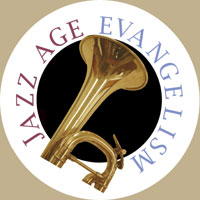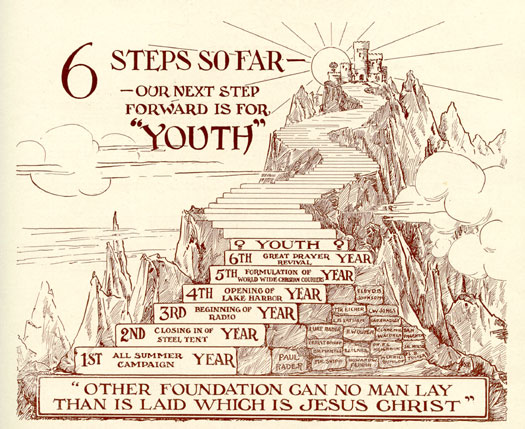| 1904 |
Ordained
on September 21st Congregational Church |
| 1904-1906 |
Pastor of Maverick
Congregational Church, East Boston. |
| 1906 |
Married Mary Caughran
on June 21 |
| 1907-1909 |
Pastor of the Holladay
Congregational church in Portland, Oregon. Resigned because of a growing
lack of conviction in his preaching and faith |
| 1907 |
Daughter Pauline
Caughran born on April 29 in Portland, Oregon |
| 1908 |
Daughter Willamine
Mary born on August 5 in Portland, Oregon |
| 1909 |
Left the pastorate
to enter business, working as a boxer and boxing promoter, then started
an oil service company |
| ca. 1912 |
Reconversion of Rader
in New York City |
| 1912-1914 |
Caretaker and eventually
assistant pastor of CMA Tabernacle, Pittsburgh, under the mentoring of pastor
E. D. Whiteside |
| ca. 1913 |
Served as a song
leader and assistant at several meetings around the country led by A. B.
Simpson |
| 1914 |
Became full-time
itinerant evangelist |
| Evangelistic meetings
in Toledo, Ohio |
| 1915 |
Evangelistic meetings
in Chicago, Illinois |
| Call to the pulpit
of Moody Church of Chicago on February 3 |
| Held evangelistic
meetings during the summer in a tent at the corner of LaSalle, North, and
Clark Streets |
| Moody Tabernacle,
at the site of the summer meetings, was opened on November 7 as the center
of Moody Church's evangelistic program in the city. The old church building
on Chicago Avenue was sold in 1917 |
| 1916 |
Daughter Harriet
Ellen born on April 1 |
| 1917 |
Evangelistic campaign
in June at the Church of the Open Door in Los Angeles, California, during
which Charles Fuller was converted |
| 1919-1924 |
President of CMA
(was vice-president, succeeded A. B. Simpson on his death) |
| 1919 |
Evangelistic campaign
in New York |
| 1920 |
Tour of Alliance
missions between May and October |
| 1921 |
Tabernacle Publishing
Company formed on April 19 |
| Left Moody Church
in September |
| 1921-1922 |
Revival tour of southeastern
United States in late-1921 and early-1922 |
| 1922 |
Gospel Missionary
Association formed on April 3 by Rader and Johnson to form the organizational
basis of a summer evangelistic campaign in Chicago |
| Founded World Wide
Christian Couriers |
| Broadcast over the
Chicago municipal station (WBU) from city hall over the next two weeks starting
June 3. Broadcast at irregular intervals from different stations for the
next three years |
| Steel Tent holds
first meeting on June 18. The campaign was announced as ending on Labor
Day. Shortly before the end of the meeting, Rader and the staff of the meetings
decide to establish the Chicago Gospel Tabernacle as a permanent church |
| First great missionary
rally on September 17 (by 1932 were supporting 192 missionaries around the
world) |
| 1923 |
Evangelistic campaign
in Philadelphia |
| 1924 |
Rader resigned as
president of the C&MA in January |
| Development of the
Young People's Life Investment Movement, which involved young people in
evangelistic outreach around Chicago |
| 1925 |
Paul Rader givens
the invocation at the first day of broadcasting of new Chicago radio station,
WHT. |
| Beginning of regular
radio broadcasts, starting on April 26, over station WHT, owned by once
and future Chicago mayor, William H. Thompson. Rader agrees to provide fifteen
hours of Sunday programming for the next ten years. |
| Held a memorial day
picnic on May 30 at Tower Lakes Park in northern Illinois. 2000 people attended.
This was the first of a series of church related events throughout the summer.
But later in the year, Rader sold the land and instead made plans for a
summer camp facility at Lake Harbor, Michigan |
| Evangelistic campaign
in Ocean Grove, New Jersey |
| First issue of National
Radio Chapel Announcer in December, a glossy magazine of over fifty
pages about the Tabernacle's radio programs and other activities. With the
June 1926 issue the name was changed to World Wide Christian Courier.
The magazine was discontinued in mid1932 |
| 1926 |
Rader filled the
pulpit of Angelus Temple from January through March during Aimee Semple
McPherson's absence |
| Fourth annual Missionary
conference, May 5-9 |
| Chicago Gospel Tabernacle
purchased a 217 acre site in May (including a half mile of beach front)
in Lake Harbor, Michigan for a summer camp. Years later, after the Tabernacle
has sold the property, this became the site of Maranatha Bible Camp |
| Opening of Lake Harbor
summer conference grounds near Muskegon, Michigan, in June |
| World Wide Christian
Couriers formed, ca. June, as a corporation to replace the Gospel Missionary
Association. WWCC served as the corporate base for all of Rader's evangelistic
activities, including the Tabernacle |
| Evangelistic campaign
in Philadelphia, September 13-November 28 |
| 1927 |
Rader supporter Albert
M. Johnson purchased the lot on which the Tabernacle stood. |
| The Tabernacle's
Sunday broadcasts on WHT reduced to five hours in June because of Federal
Radio Commission regulations |
| Clarence Jones, of
the Tabernacle staff, dedicates his life to foreign missions during a summer
conference at Lake Harbor. He begins plans which eventually result in his
founding, with Reuben Larsen, missionary radio station HCJB in Quito, Ecuador |
| Reached agreement
in September with station WJBT for Sunday broadcasts and the use of WBBM's
transmitter |
| Christian Courier
Club formed at the Tabernacle. The purpose was to involve laymen in evangelistic
efforts, visiting homes, factories and prisons and holding street meetings |
| 1928 |
F. F. Bosworth starts
a series of evangelistic meetings (January 4- ?) at the tabernacle, with
the Tindley Jubilee Gospel Singers |
| Paul Rader holds
evangelistic meetings in Fort Wayne, Indiana, February 14-18 |
| Sixth Missionary
Conference, May 30-June 3 |
| The Metropolitan
Tabernacle (soon renamed the Cosmopolitan Tabernacle) started in Toronto
on September 9, under leadership of Oswald J. Smith, who becomes the World-Wide
Christian Courier's Canadian Director. The Tabernacle met in Massey Hall. |
| River Lake Gospel
Tabernacle, under the leadership of Luke Rader (brother of Paul) opened
on November 18 in Minneapolis. It is closely affiliated with the Chicago
Gospel Tabernacle. The Tabernacle grew out of meetings Luke Rader held in
the city beginning in July. The Tabernacle continues to be a prominent church
in the city for years to come |
| 1929 |
Gerald B. Winrod
becomes interim pastor of the Tabernacle in July while Rader is away on
his missionary journey |
| Missionary journey
(August 5-December 25) by Rader to visit missionaries supported by the Tabernacle
and to lead evangelistic meetings in 22 cities, including Tokyo, Peking,
and Shanghai. His travels took him to China, Japan, Borneo, India, Palestine,
France, and England. |
| On his
way home from London , Rader broadcast on December 22 on the ocean to 4,000
in the Tabernacle as well as the radio audience |
Postcard
of Paul Rader with a facsimile of his signature. These cards were
available in the Tabernacle bookstand. Undated. |
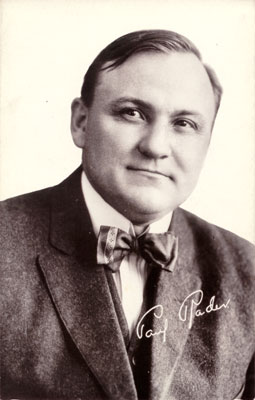 |
|
| 1930 |
Tabernacle
"Breakfast Brigade" broadcasts were carried over twenty-six stations
(starting on April 28) on the east coast and the midwest over the
CBS Network at 7am for seven days a week. The arrangement proved too
expensive and was canceled by the summer. |
| Billy Sunday
led evangelistic meetings at the Tabernacle, May 25-31 |
| Lake Harbor
Conference Ground opened for the season on June 28, which continued
until September 1. |
| Rader led evangelistic
meetings in Dixon, Illinois, July 20-August 16 |
| The Tabernacle
ended its broadcasts over WJBT on August 17. The Tabernacle continued
to broadcast a few hours of programs over a variety of stations until
the beginning of 1933. |
| Held meetings
in Los Angeles |
| W. B. Hogg
joined the Tabernacle and served as Rader's replacement during Rader's
world wide missionary journey |
| Richard W.
Oliver, of the Tabernacle staff, died in an auto accident on October
22 |
| Farewell ceremony
on November 2 for Rader and the missionaries traveling with him. His
trip would include Toronto and Montreal, Ireland (where he held evangelistic
meetings), Scotland, England, Italy, Greece, Egypt, Palestine, India,
Singapore, Java, Bali, Borneo, the Philippines, Hong Kong, China,
Japan, Vancouver |
| Rader held
a revival campaign in Belfast, Ireland, November 16-December 7 |
| 1931 |
Rader began
an evangelistic campaign in Bombay, India, on January 10 |
| Rader returns
to Chicago from his missionary tour on May 4 |
| Missionary
conference, May 4-10 |
| Evangelistic
meetings in Milwaukee, Wisconsin, in July lead by Ralph Rader, led
to the start of a Tabernacle in that city, under George Ziemer |
| Clarence Jones,
his family, and transmitter for the missionary radio station in Ecuador,
HCJB, was dedicated to the Lord's service on the platform of the Tabernacle
on August 2. Tabernacle members provide much of the support for the
early ministry of HCJB. |
| Series of evangelistic
meetings in Detroit in August leads to the formation of a Tabernacle
in that city, under Rev. E. J. Rollings |
| Milwaukee Tabernacle
opened in September |
| C. L. Eicher
resigned as director of the Tabernacle's mission program on November
5 |
| A Family Foundation
was set up to help people in economic distress |
| 1932 |
Rader led evangelistic
meetings in Los Angeles in January, which resulted in the founding
of a Tabernacle in that city, pastored by W. B. Hogg. Paul Fleming
dedicated his life to the Lord during these meetings |
| The Tabernacle
staff led by Rader redesigned the World Wide Christian Couriers to
become a network of small clubs of men and women that studied the
Bible and engaged in grass roots evangelism in their neighborhoods.
Handbooks and other curriculum were prepared to help train them and
bi-monthly conference were held to exchange experiences and help build
enthusiasm. By the fall, sixteen other tabernacle, mainly in Midwestern
cities, were starting Courier clubs in their cities. By the end of
the year, fifty Courier classes were going in Chicago. |
| Rader holds
evangelistic meetings in Plattsville, Illinois, in May and starts
a tabernacle there. |
| Annual missionary
conference, May 29-June 4 |
| Paul Rader's
Pantry formed (ca. June) to gather and can food for the needy. By
the end of the year, the Pantry had fed 41,000 families, including
100,000 children |
| Chicago mayor
Anthony Cermak participated in 10th anniversary celebration |
| First issue
of The Courier, an eight page newspaper of Tabernacle activities,
with emphasis on the Courier Clubs, is published on October 8 |
| By October,
in a number of cities throughout the Midwest, Rader has either started
a Tabernacle or entered into some kind of affiliation with an existing
independent church. These churches served as centers for Courier clubs.
There are affiliated tabernacles in Akron, Appleton, Aurora, Des Moines,
Detroit, Freeport, Elgin, Galesburg, Los Angeles, Milwaukee, Muscatine,
Platteville, Mt. Clemmens, Royal Oaks, and Zion. |
| A.M. Johnson
no longer able to maintain the payments (October) on the lot in which
the Tabernacle stood. Rader personally signed a note taking over the
payments. |
| First Tamasha
(Courier bi-monthly conference) held at the Tabernacle on November
18 |
| Toward the
end of the year, several of the Tabernacle staff had to be let go
because of lack of funds |
| Radio program
The Back Home Hour went off the air in December. It was later
continued by Luke Rader, among others. |
| 1933 |
Paul Rader
went to Los Angeles on February 12 to attend to difficulties with
the tabernacle in that city. Clarence Ericksen substituted for him
in Chicago. Rader then was legally unable to leave California because
of the debts owed by the Los Angeles Tabernacle |
| Because of
lack of funds, Tabernacle radio ministry went off the air in February
|
| Because of
overwhelming debts against the World Wide Couriers organization, Rader
decided in April the Couriers should declare bankruptcy and severed
it from the Tabernacle, and resigned as pastor. Clarence Ericksen
became his successor, assisted by Merrill Dunlop. |
| Last issue
of The Courier published on April 29 |
| Lance Latham
founds the North Side Gospel Center in Chicago and is joined by several
Tabernacle families. The first service is held on Easter Sunday. Latham,
who had been in charge of Tabernacle Scouts, the Tabernacle's program
for boys and the White Shirt Brigade, a boys choir, later (1950) founded
the Awana Clubs, a Christian youth ministry |
| Rader received
DD and LLD from Bob Jones College on May 31 |
| Rader led summer
revival meetings during the Chicago World's Fair |
| The Chicago
Gospel Tabernacle resumes the broadcasting in the Fall of "The Heaven
and Home Hour" under Clarence Ericksen |
| 1934 |
Rader led summer
revival meetings during the Chicago World's Fair |
| WWCC was reorganized
at the World Wide Gospel Couriers on August 10 |
| 1935 |
Bankruptcy
of the World Wide Christian Couriers finally resolved in court and
assets divided in May |
| Rader became
pastor of the Fort Wayne Gospel Tabernacle in Fort Wayne, Indiana
until 1936. Paul Fleming, who later founded New Tribes Mission, was
assistant pastor. |
| Evangelistic
meetings in Detroit |
| 1937 |
Chicago Gospel
Tabernacle incorporated as a church in March |
| Paul Rader's
preaching tour of Great Britain cut short by illness |
| 1938 |
Returned to
California in the United States in January. Remained ill and in the
late spring was admitted to Hollywood Hospital. |
| Died on July
19 in Hollywood Hospital, Los Angeles, California of cancer of the
prostate |
| Funeral services
on July 22 at the First Presbyterian Church, Hollywood attended by
over 2,500. Buried at Forest Lawn Memorial Park in Glendale, California |
| 1939 |
World Wide
Christian Couriers was dissolved in January |
| 1963 |
Congregation
sells the Tabernacle building and moves to another building on Sheffield
Avenue, retaining the name "Chicago Gospel Tabernacle." The original
building became a supermarket and later a sports supply store. |
| 1979 |
The congregation
of the Chicago Gospel Tabernacle disbanded. Remaining financial assets
are given to missionaries the church supported and to Moody Bible
Institute to start the Chicago Gospel Tabernacle-Paul Rader fund to
support education for inner-city students. |
click
for exhibit samples |
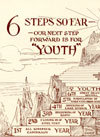 |
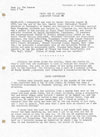 |
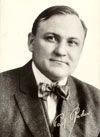 |
Courier
illustration |
Rader's
conversion story |
Photo
postcard
of Rader |
|
|
